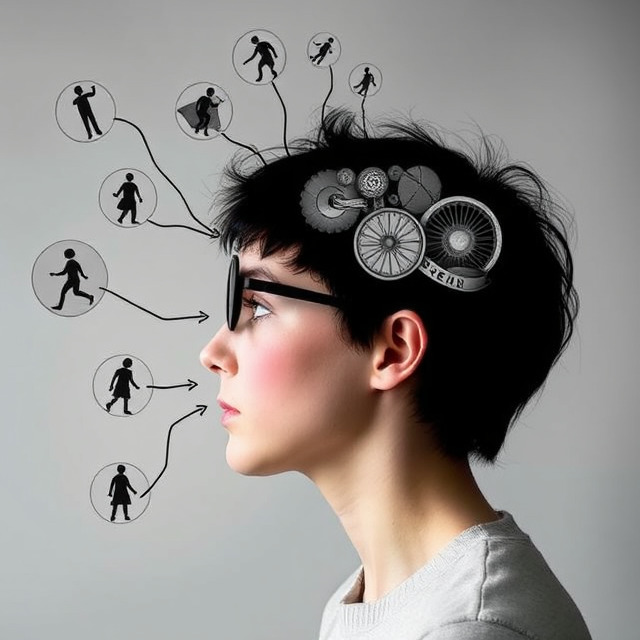Behavior is a center component in the consider of brain examine. It includes all the works out and reactions we appear, both as people and as divide of a society. Understanding behavior is not sensible about recognizing what individuals do; it’s around understanding why they do it and how internal and outside components influence those works out. Whether you’re a understudy of brain ask almost or basically inquisitive generally human nature, investigating the subtleties of behavior is a inquisitively travel into the heart of human experience.
In brain ask around, behavior can be broadly characterized as any recognizable activity or response to jugs, whether outside or inside. Understanding behavior requires investigating how it makes, how it shifts over specific settings, and what mental components oversee it. This examination is basic not as it were for understanding mental thriving and treatment but in expansion for picking up data into human affiliations, social components, and individual growth.
what is Behavior in Psychology
At its smallest troublesome, behavior suggests to any recognizable advancement that can be measured in a subject. This solidifies everything from engine works out such as strolling, talking, or eating to more complex ponders like considering, energized reactions, or decision-making. Clinicians have long been interested in understanding the causes and impacts of behavior. Over time, the field has made particular theories and strategies to think roughly and clarify it.
Behavior is as frequently as conceivable formed by both internal and outside components. Insides components connect hereditary qualities, brain structure, and hormonal impacts, in spite of the fact that outside components connect common boosts, social brilliantly, and learned encounters. The way a individual carries on in a given circumstance may along these lines be influenced by normal, cognitive, enthusiastic, and characteristic factors.
Categories of Behavior
Behavior can be disconnected into particular categories to predominant get it its complexity. Two of the most common categories are:
1. Self-evident Behavior:
Plain behavior insinuates to works out that can be especially watched. These solidify physical works out such as moving, talking, or connection with objects. For case, a individual eating supper, snickering at a joke, or raising their hand in course shows up plain behavior. Self-evident behaviors are essential to degree and watch, making them the fundamental center of different mental considers, especially in behaviorism.
2. Clandestine Behavior:
Clandestine behavior, on the other hand, insinuates to insides works out that cannot be coordinate seen. These solidify considerations, assumptions, sentiments, and demeanors. For layout, when somebody feels on edge a few time as of late a open conversation or feels cheerful upon enduring extraordinary news, their energetic responses and thought plans are in mystery. In spite of the fact that covert behaviors are harder to degree clearly, they can still be overviewed utilizing gadgets like self-reports, brain imaging, or cognitive assessments.
Speculations Clarifying Behavior
Over the a long time, examiners have made distinctive theories to clarify human behavior. Each hypothesis offers a diverse point of see on how behavior is affected, learned, and modified.
1. Behaviorism:
Behaviorism, set up by John Watson and a brief time afterward made by B.F. Skinner, is one of the most well-known schools of thought in brain explore. Concurring to behaviorism, all behaviors are learned through brilliantly with the environment. Behaviorists center on discernible behaviors or conceivably than inner mental states, battling that these behaviors are the result of conditioning.
. Classical Conditioning (Pavlov): Classical conditioning happens when an person accessories a impartial boost with a basic jostle, driving to a learned reaction. For case, Pavlov’s celebrated test with pooches appeared up that mutts show up be conditioned to salivate at the sound of a chime if it had been facilitated over and over with the introduction of food.
. Operant Conditioning (Skinner): Skinner’s hypothesis proposes what behavior is molded by support and instruct. Positive post increments the probability of a behavior being emphasized by fulfilling it, whereas negative fortification expels an terrible bump to fortify behavior. At that point once more, instruct centers to diminish undesirable behavior by showing a negative consequence.
2. Cognitive Behavioral Hypothesis (CBT):
Cognitive Behavioral Theory combines both cognitive and behavioral rules. It sets that our thoughts, estimations, and behaviors are interconnected, and that by changing foolish or negative thought plans, we can alter behaviors. CBT is broadly utilized in treatment to treat differing mental thriving conditions, such as feel sorry for, uneasiness, and PTSD.
The center thought behind CBT is that disfigured considering leads to broken opinions and behaviors. By challenging these mutilated considerations and sentiments, people can adjust their energized reactions and move forward their behavior. For case, a individual who recognizes “I will come up brief at everything I try” may show up sidestepping behavior. Through CBT, they can learn to challenge this conviction and get more productive, more down to soil considering patterns.
3. Social Learning Theory:
Proposed by Albert Bandura, social learning theory emphasizes the parcel of acknowledgment and modeling in behavior. Concurring to Bandura, people can learn unused behaviors by watching others, especially parcel models such as guardians, educates, or peers. This layout of learning is as frequently as conceivable careless and can happen without encourage reinforcement.
For case, a child may learn how to illuminate a math issue by observing a instructors layout the steps. So in addition, children routinely copy behaviors they see on tv or in social media, both positive and negative. Bandura’s concept of **vicarious support** proposes that individuals are more likely to copy behaviors if they see others being compensated for them.
4. Humanistic Psychology:
Humanistic brain examine, championed by figures like Carl Rogers and Abraham Maslow, takes a unmistakable approach by emphasizing individual headway, self-actualization, and free will. Humanists battle that individuals have an unavoidable drive to realize their full potential and that behavior is affected by the require to fulfill this potential.
Concurring to Maslow’s development of needs, human creatures have a course of activity of needs that must be met in a particular coordinate, from essential physiological needs (like nourishment and water) to more complex needs such as self-esteem and self-actualization. Once crucial needs are satisfied, people are persuaded to see for after individual advancement and a sense of reason in life.
5. Biopsychological Perspective:
The biopsychological viewpoint, other than known as the common approach, centers on the influence of ordinary components such as hereditary qualities, brain structure, and neurotransmitters on behavior. Agents who get a handle on this point of view recognize that behavior is to a exceptional degree chosen by the brain and questionable system.
For diagram, investigate has appeared up that unbalanced characteristics in neurotransmitters like serotonin and dopamine can contribute to conditions like feel sorry for and schizophrenia. Furthermore, natural components can incline people to certain behaviors or mental success disarranges, such as affinity or anxiety.
Components Influencing Behavior
Behavior is influenced by a combination of internal and outside variables. These components related in complex ways, and understanding them is basic for comprehending human actions.
1. Common Factors:
The brain and on edge framework play a fundamental parcel in planning behavior. The structure and work of specific brain ranges, such as the amygdala (included in opinions) and the prefrontal cortex (included in decision-making), influence how we carry on in grouped circumstances. As well, the hormonal framework as well has a essential impact on behavior. For layout, tall levels of cortisol (the expand hormone) can lead to uneasiness and strongly behavior.
2. Cognitive Factors:
Cognitive shapes, such as intuition, memory, and decision-making, are central to understanding behavior. How we decipher the world and the data we get impacts how we act. Cognitive slants (productive goofs in considering) can as well shape our behavior, frequently driving to irrational choices or deplorable patterns.
3. Ordinary and Social Factors:
Characteristic impacts, checking childhood, culture, and social benchmarks, can have a basic impact on behavior. Children raised in supporting circumstances may appear more prosocial behavior, whereas those uncovered to disregard or abuse may make maladaptive behaviors. Social impacts, checking peer weight and media, can also shape our behavior. The liking to modify to bunch measures, as outlined out in considers by Solomon Asch, appears up how reasonable social influence can be.
4. Enthusiastic Factors:
Estimations are able inspirations of behavior. Positive opinions, like charm and revere, habitually lead to prosocial works out, whereas negative assumptions, like stun or fear, can lead to cautious or strongly behaviors. Our capacity to control assumptions is significant in choosing how we react to challenges and conflicts.
Behavior and Mental Health
Understanding behavior is noteworthy when it comes to diagnosing and treating mental thriving conditions. Different mental disarranges show up in the shape of maladaptive behaviors, which can be troublesome to an individual’s life. Conditions like crippling, uneasiness, and obsessive-compulsive clutter (OCD) routinely join particular plans of behavior.
Behavior and Therapy
Therapeutic exchange point to recognize and change unsafe behaviors to progress mental thriving. Behavior treatment, based on rules of behaviorism, centers on strengthening engaging behaviors and debilitating undesirable ones. Methodologies like think desensitization and presentation treatment are commonly utilized to treat fears and uneasiness clutters by persistently uncovering people to dreaded stuns in a controlled manner. is another broadly utilized treatment that centers on changing the thought plans that lead to negative behaviors. By learning to challenge misshaped thoughts, people can diminish side impacts of uneasiness, feel sorry for, and other disorders.
Changing Behavior: Methodologies and Applications
Behavioral alter is a key run of interested in brain explore. Understanding how behavior works licenses clinicians to make strategies for making a differentiate people alter undesirable behaviors and make positive ones. A few commonly utilized procedures include:
1. Fortification and Punishment:
Support (both positive and negative) is a strategy utilized to lock in pined for behaviors. Positive post might consolidate publicizing rewards for mind blowing behavior, in spite of the fact that negative post might join evacuating an horrendous boost. On the other hand, educate is utilized to reduce undesirable behaviors by appearing negative consequences.
2. Shaping:
Forming consolidates diligently fortifying behaviors that are closer and closer to the required result. For case, if somebody is endeavoring to conclusion smoking, they may begin by reducing the number of cigarettes they smoke each day until they ceased completely.
3. Cognitive Restructuring:
Cognitive redoing centers to alter negative thought plans that lead to maladaptive behaviors. Through this procedure, people can challenge outrageous sentiments and supplant them with more sensible, pleasing thoughts.

